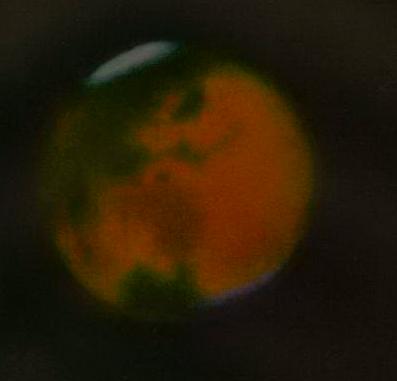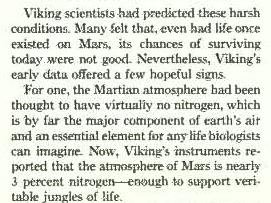


A better example, is probably that of Mars. The theories and ideas about the planet range from absolute existence of life, to possible existence of vegetation, to a probability of only micro-organisms, to no life for sure, and then the focus shifts from finding life to getting there:
New Light on the Changing face of Mars
Sep 1955
From Bloemfontein, South Africa, the National Geographic-Lowell Observatory Mars Expedition last summer took 20,000 photographs of the planet on which life as we know it is most likely to exist. Here Mars, inverted as the astronomer sees it in a telescope, reveals springtime details of its southern hemisphere; the planet appears 2,700 times larger than to the unaided eye.
... a scany water supply melting from the poles quickens some form of vegetation...

Mars, A new world to explore
Carl Segan, Author of Contact
Dead or Alive? Scientists have long pondered the riddle of the planet's polar caps and ocher landscape that change with the seasons. Now space technology promises to reveal in the next decade whether earth's neighbour harbors life or spins through eternity as a sterile desert.

(Man)... began to speculate on the possibility that Mars is inhabitated. Astronomers peering through telescopes at the fuzzy orange ball, sought on Mars an answer to the ancient haunting question: Is there life out there?
We will be ready for interplanetary travel by the 1980s
-Dec 1967
Voyage to the Planets
1970

Mars, the abode of a race of intelligent canal builders in the eyes of Percival Lowell, has proved to have no canals and offers no evidence of water in liquid form, or of anything else that would encourage life as we know it on Earth.
The search of life on Mars
Inquest of living organisms, Viking landers such as this full-scale model will scoop up Martian soil with ten foot retractable arms. One of the cell supplies nutrients that some scientists call "chicken soup" to feed the Martian bugs. If the organism grow, metabolize or reproduce, they will betray their presence to Viking, which will relay the news to a waiting world.
1973
Sifting for life in the sands of Mars
1977


The planets, between fire and Ice
1985
MORE DEAD THAN RED, Mars has terrain that bears reseblance to our own Death valley, California. But Mars' soil is rich in rust though devoid of life - such was the verdict of the Viking 1 and 2 missions.
Mission to Mars 1988
Solar Sails will Power ships to a New World 1988
Sending a Little Truck on a Journey to Mars 1993
1 comment:
AMAZING article.... loved it.. didn't know NAT-GEO was so old man... cool stuff abt MARS.. we have to admit we had pretty weird ancestors...
Post a Comment